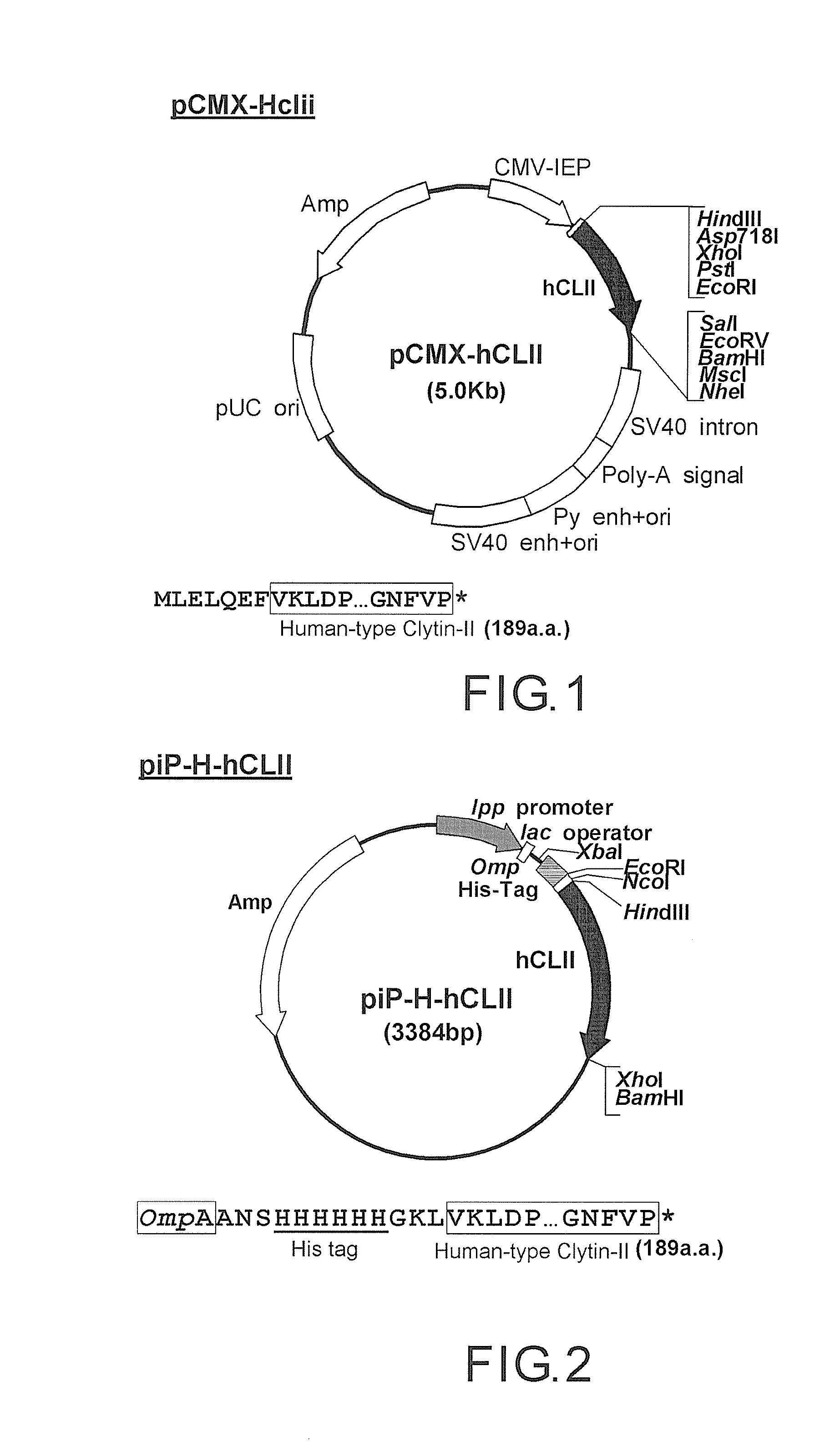Codon-optimized nucleic acid for coding apo-clytin-ii and method for using the same
a technology of apo-clytin-ii and nucleic acid, which is applied in the field of codon-optimized nucleic acid for coding apo-clytin-ii protein, can solve the problems of low expression level of apo-clytin-ii protein, no actual evidence of stable expression of recombinant clytin-ii in eukaryotic cells or a host, and no study on the usefulness o
- Summary
- Abstract
- Description
- Claims
- Application Information
AI Technical Summary
Benefits of technology
Problems solved by technology
Method used
Image
Examples
example 1
Design and Chemical Synthesis of the Codon-Optimized apo-clytin-II Nucleic Acid
[0112]The codon-optimized apo-clytin-II nucleic acid is designed in the following manner (Sequence list 3): without changing the amino acid sequence of apo-clytin-II, using the amino acid codon frequently used in human body, and converting the transcription factor recognition sequence into a non-activated sequence, removing the site that may be subjected to splicing, eliminating six restriction enzyme sites for base recognition, and without forming a palindrome sequence to make a loop structure. The codon usage frequency of the codon-optimized apo-clytin-II is shown in Table 2. Compared with the codon frequency of wild-type apo-clytin-II in Table 1, the codon-optimized apo-clytin-II nucleic acid is obviously an optimized design based on the humanized codon.
[0113]The optimized design codon-optimized apo-clytin-II nucleic acid of is synthesized by routine method and chemical synthesis. The cloning is perfor...
example 2
Construction of the Codon-Optimized apo-clytin-II Protein Expression Vector in Cultured Animal Cells
[0114]The construction of the codon-optimized apo-clytin-II protein expression vector is as follows. Firstly, a novel expression vector pCMX-Linker is constructed in cultured animal cells. Specifically, in pCMX-GFP (described in Ogawa et al., (1995) PNAS. 92(25), 11899-11903), linkers Linker F(5)A-Sal (5′ GT ACC ACC ATG CTC GAG CTG CAG GAA TTC TCT AGA G 3′) (SEQ ID NO: 7) and Linker R(5)A-Sal (5′ TC GAC TCT AGA GAA TTC CTG CAG CTC GAG CAT GGT G 3′) (SEQ ID NO: 8) having a chemical synthesized multiple cloning sequence is inserted at the restriction enzyme site, i.e., the Asp718 / SalI site, to construct the novel expression vector pCMX-Linker. That is, the novel expression vector is controlled by the CMV promoter, which has the Kozak sequence and multiple cloning site sequence (Asp71811 XhoI / PstI / EcoRI / XbaI / SalI / EcoRV / BamHI / MscI / NheI) in the downstream.
[0115]Thereafter, the codon-optimi...
example 3
Introduction of the Vector into Cells
[0117](1) Truncation and Purification of Expression Plasmid
[0118]The pCMX-hCLII plasmid obtained in Example 2 is used to perform the following experiments. The pCMX-hCLII plasmid is purified in E. coli JM83 by using Endofree Plasmid Maxi kit (manufactured by QIAGEN Company), and then dissolved into sterilized water to a concentration of 1 μg / μl. Similarly, pCMX-hCLII and the firefly luciferase vector (pGL-control: Promega Company) applied as internal standard are used.
[0119](2) Transfection
[0120]The cell line from human cervical cancer, i.e., HeLa line, is cultured with DMEM medium (with high-concentration glucose, Wako Chemicals) containing 10% fetal bovine serum (Invitrogen Company), and seeded in 6-well culture dish in 2×105 cells / well, and cultured in an incubator under the condition of 37° C. and 5% CO2. After 24 hours, by using a FuGene HD transfection kit (Roche Company), the purified pCMX-hCLII plasmid is transfected into the HeLa cell in...
PUM
| Property | Measurement | Unit |
|---|---|---|
| Volume | aaaaa | aaaaa |
| Volume | aaaaa | aaaaa |
| Mass | aaaaa | aaaaa |
Abstract
Description
Claims
Application Information
 Login to View More
Login to View More - R&D
- Intellectual Property
- Life Sciences
- Materials
- Tech Scout
- Unparalleled Data Quality
- Higher Quality Content
- 60% Fewer Hallucinations
Browse by: Latest US Patents, China's latest patents, Technical Efficacy Thesaurus, Application Domain, Technology Topic, Popular Technical Reports.
© 2025 PatSnap. All rights reserved.Legal|Privacy policy|Modern Slavery Act Transparency Statement|Sitemap|About US| Contact US: help@patsnap.com

